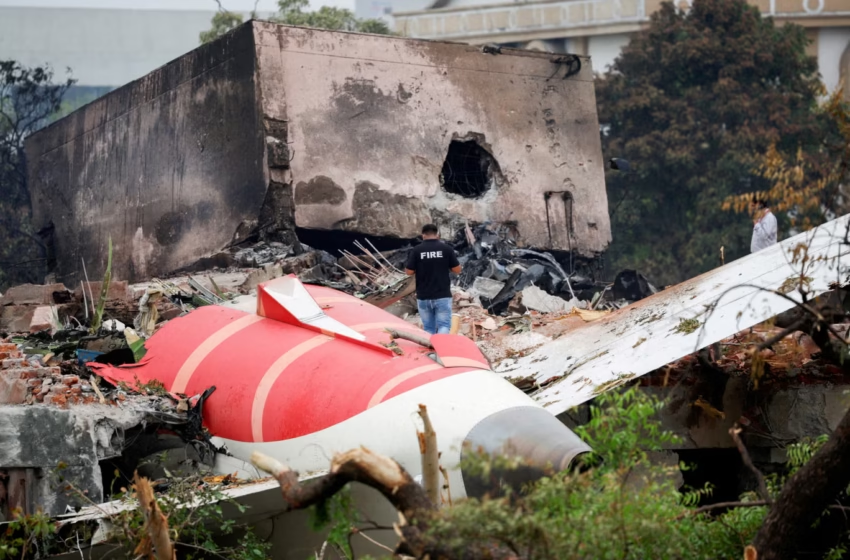Air India: What losing engine power mid-air really means for airline safety

Aftermath of the Air India crash during takeoff in Ahmedabad (Adnan Abidi/Reuters)
A recent investigation into the tragic crash of Air India Express Flight 171 has revealed a startling finding: both engines lost power just seconds after takeoff due to a fuel cutoff. For many people, this technical explanation raises more questions than answers.
What does it mean for a plane’s engines to “lose power after fuel cutoff”? How could this happen on a modern aircraft like the Boeing 737 MAX, and what can we learn from it?
Here’s a breakdown that makes sense of the jargon and shows why this rare occurrence is both alarming and instructive.
What the Investigators Found
According to the preliminary report by India’s Aircraft Accident Investigation Bureau (AAIB), the plane’s engines were manually shut down mid-air—not because of a malfunction, but because the fuel control switches were moved from “RUN” to “CUTOFF” shortly after takeoff.
This movement cut off fuel to both engines, resulting in a complete loss of thrust. Within 30 seconds, the plane crashed. Shockingly, cockpit audio revealed that the pilots themselves seemed confused by what happened, with one asking, “Why did you cut off?”
What Is a Fuel Cutoff—and Why Is It Serious?
Modern aircraft like the Boeing 737 MAX are equipped with fuel control switches that allow pilots to manage engine fuel flow. These switches have two positions:
-
RUN: Normal fuel flow to the engine
-
CUTOFF: Shuts off fuel and kills engine power instantly
These switches are protected by covers to prevent accidental movement. Switching them to CUTOFF is usually only done on the ground during engine shutdown. Doing so in-flight is highly irregular and extremely dangerous.
READ ALSO
Air India crash: engines lost power after fuel cutoff, early report reveals
Air India Boeing 787 crash: What we know so far
Investigators analyzing Air India plane crash…here’s the latest update
Air India crash caused by faulty pilot seat, report reveals
Another Air India plane suffers technical issue midair, nearly crashed
Air India crash, Toronto tragedy… top plane accidents in 2025
India Air Crash: Pilot’s last words, sole survivor, other heartbreaking
Ahmedabad: Moment London-bound plane with 242 passengers crashed in India
What Happens When Engines Lose Power After Takeoff?
An airplane’s engines provide more than just forward motion. They also power:
-
Hydraulic systems (controls for landing gear, flaps, etc.)
-
Electrical systems (instruments, lights, navigation)
-
Pressurization and air conditioning
In this case, both engines failed simultaneously. A backup device called a Ram Air Turbine (RAT) deployed to supply emergency power, but this device does not generate thrust. With no engine power and low altitude, the pilots had no time or speed to recover. Attempts to restart the engines came too late.
Could This Have Been Accidental?
Investigators are still piecing this together. The switches are designed to prevent accidental movement, so it’s unclear how they were both moved to CUTOFF within one second of each other. The crew denied doing so. The report doesn’t accuse anyone directly, but it raises serious concerns about human error, cockpit coordination, or possibly a misunderstanding of procedure.
What Makes This Incident So Alarming?
-
Fuel starvation is preventable – Unlike bird strikes or bad weather, shutting off engine fuel is avoidable.
-
Dual engine failure is extremely rare – Losing both engines right after takeoff gives pilots very little room to respond.
-
Pilots were reportedly unaware – This points to possible confusion, poor training, or system mismanagement.
Are There Similar Incidents?
Yes, but rarely. In 2020, a Pakistan International Airlines flight lost both engines after a gear-up landing attempt caused major damage. In 2009, US Airways Flight 1549 (the “Miracle on the Hudson”) lost both engines after a bird strike—but in those cases, the engines failed due to external factors, not fuel cutoff by human hands.
What Happens Next?
-
Further investigation will focus on why the switches were moved, and whether cockpit layout, human error, or systemic issues were involved.
-
Training procedures and checklists may be reviewed globally, especially for fuel management during takeoff.
-
Design safeguards may be reconsidered to prevent unintended switch movements or to detect such events earlier.
What This Means for the Flying Public
While the findings are unsettling, it’s important to know that commercial aviation remains one of the safest modes of transport. What makes this case stand out is how simple human actions—switching off fuel—had catastrophic consequences.
Passengers can be reassured that incidents like this are extremely rare, and investigations like this are designed not only to find fault, but to make flying even safer going forward.

